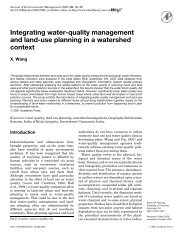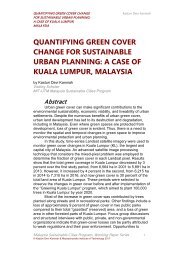You also want an ePaper? Increase the reach of your titles
YUMPU automatically turns print PDFs into web optimized ePapers that Google loves.
the former category, and by and large, their way of coping was to run to<br />
the shelter. In Segamat, by contrast, residents learn to adapt.<br />
As compared to rural communities and urban slums with<br />
homogenous socioeconomic characteristics, urban residents living in<br />
private residential areas are not well organized among themselves, and<br />
therefore tend to take action individually rather than collectively. Many<br />
residents were not even aware that their homes were located in a floodprone<br />
area. They considered access to school, market, and town facilities<br />
when they were buying a home, and flood risks simply were not among<br />
their criteria. The local zoning maps don’t show flood plains, most of which<br />
are zoned for residential, commercial, or institutional use.<br />
Local authorities failed to have a reliable early flood warning system<br />
in place. Many residents said that they did not receive flood warnings. The<br />
authorities’ approach to flood management is top-down, with little<br />
involvement of local residents in flood-related planning. The local<br />
authority’s ability to supply food and relief materials in flooded areas was<br />
weak—for example, firefighters did not have sufficient manpower or<br />
equipment to respond to the rescue need, and there was a lack of security<br />
forces to protect properties in flooded areas. In some cases, rescue and<br />
relief operations were not carried out in a fair manner.<br />
To be fair, the 2006 and 2007 flood did educate residents and local<br />
authorities to some extent. The residents learned where to go in case of a<br />
flood. Some residents extended one floor up their house to create spaces<br />
to protect themselves and their valuable goods. Others sold their<br />
properties to move to higher ground. Local authorities and DDMRC began<br />
to meet frequently before the rainy season, to make sure rescue and relief<br />
plans were in place.<br />
What more needs to be done?<br />
The capacities to cope and adapt are the two frames applied by this<br />
research to examine how local residents and local authorities deal with<br />
flood disasters in urban Malaysia. This section therefore draws a number<br />
of lessons from Malaysia for improving the coping and adapting capacity—<br />
of both local residents and local authorities—in dealing with city flooding<br />
all over the world.<br />
Coping strategies<br />
The flood experiences from Malaysia have provided a number of<br />
lessons for coping with flood disaster. First, during rainy or flooding<br />
season, residents should keep an eye outside their home and remain alert<br />
while performing their day-to-day activities, both inside and outdoors. The<br />
residents should keep their valuable assets and cars on higher grounds if<br />
they begin to experience heavy and continuous rain in their area. If<br />
evacuation is necessary, they should go to the shelter during the day, to<br />
avoid the need for night-time rescue. Obviously, residents should make<br />
sure that the place where they take refuge is safe from flooding.<br />
Malaysia Sustainable Cities Program, Working Paper Series<br />
© Tej <strong>Karki</strong> & Massachusetts Institute of Technology 2016<br />
12






